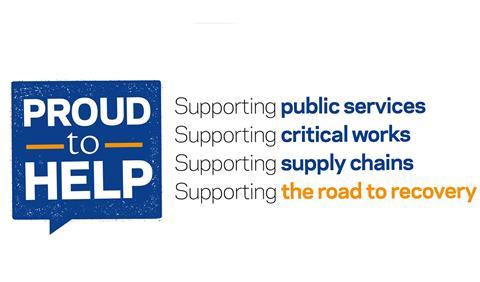The CLC-led will be launching a recovery plan for the industry, Simon Rawlinson sets out how you can get involved

Eight weeks ago, I wrote my first column working from home. At the time, as an industry, we were only just starting to get used to the practicalities of remote working and to understand the implications of the lockdown.
Fortunately, the Construction Leadership Council (CLC) had already convened a cross-industry task group, and even as the first sites started to close down, task group teams were developing the Site Operating Procedures, guidance on contracts and essential intelligence on the availability of critical materials.
It has not been an easy process. We know that the industry is diverse and that the interests of clients, main contractors and the supply chain are not easy to align. Agreeing guidance such as the Site Operating Procedures (SOP) was difficult, but the hard-won consensus has held.
The task group, comprising many of the industryŌĆÖs leading representative organisations, has proved to be a real success. It has presented a united and credible front to government, has pooled resources to enable a fast response and has developed coherent plans both to deal with the immediate crisis and to plot out the recovery.
This three-stage plan seeks not only to equip the industry to respond to the Covid-19 crisis, but also to face the greatest challenges of the day ŌĆō the net-zero challenge
The task group is now finalising preparations to move to the next stage, completing the development of an industry recovery plan. The next stage is engagement with industry, which will help to ensure that the CLC can demonstrate the sector support prior to the next stages of discussion with government and other industry partners.
The plan has three main aims. Firstly, it sets out to support the widest possible restart of work consistent with safety guidelines ŌĆō maximising employment across the supply chain. Secondly, it will aim to reset the work pipeline ŌĆō combining measures to increase demand for construction with steps to improve productivity, safety and the professionalism of the sector. Finally, the plan must drive the reinvention of the way that we work ŌĆō consistent with the priorities set out in the construction sector deal. This will involve wider adoption of the digital and manufacturing technologies, together with new practice in procurement and project management to deliver better value and whole life performance.
This three-stage plan seeks not only to equip the industry to respond to the covid-19 crisis, but also to face the greatest challenges of the day ŌĆō the net-zero challenge for both new build and retro-fit, the implementation of a new building safety culture, the delivery of an unprecedented investment programme and the acceleration of innovation in the sector. In the same way that the covid-19 crisis has enabled the health sector to adopt 20 yearsŌĆÖ worth of innovation in a matter of weeks, our sector must also start thinking the unthinkable ŌĆō a point made very clear by transport secretary Grant Shapps earlier this month when announcing a programme of transport investment.
What I have set out is only the outline, the detail of the plan maps out the ways in which each sector ŌĆō housebuilding, repair and maintenance, infrastructure and buildings can accelerate their recovery through a combination of self-help, collaborative working with clients and targeted interventions by government. The detail of the plan is still being finalised and the outcome of these discussions will depend, to an extent, to the degree to which the construction sector can demonstrate that support to its programmes and investments will deliver the best outcomes ŌĆō through jobs and businesses saved and essential homes, infrastructure and maintenance delivered.
Our ambition is that the recovery plan will make it easier for businesses to plot their way out of the downturn
So, what is your role in the recovery plan? Firstly, we need the industry to engage with the plan when it is published. The time for review will inevitably be limited, as time is of the essence, but we want to be sure that we have focused on the critical issues for industry recovery. It will not be possible to address every detailed requirement in the plan, and the task group must tread a fine line between representing the interests of the sector and crafting a proposal that represents good policy.
Secondly, we want the plan to be noticed. The Site Operating Procedures have become well established because the industry has adopted them consistently and because we talk about them. So, share the plan on social media, encourage friends and colleagues to read and discuss. LetŌĆÖs create some noise so that when government finally comes to consider its response to the plan, it knows that there is an industry lined up behind it on the other side of the deal.
Finally, we want the plan to be adopted, so build it into your business plan. Our ambition is that the recovery plan will make it easier for businesses to plot their way out of the downturn because the steps that each business needs to take will be clear and easier to adopt because the industry is following the same script.
As members of the CLC task group, we believe that the recovery plan has real credibility. This is because the plan has been developed by our sector coming together in the crisis. Collectively, we have demonstrated initiative by keeping sites open and by developing and adopting the SOP, and we have worked constructively with ourselves and with government since March to address issues as diverse as payment, materials availability and insurances.
Everyone is grimly familiar with the saying that you mustnŌĆÖt waste a crisis. So far, construction has stayed on the front foot and we are ready to take the next steps to restart, reset and reinvent our industry. I am confident that we will all want to play our part in the journey.
Simon Rawlinson is a partner at Arcadis and a member of the Construction Leadership Council






























No comments yet